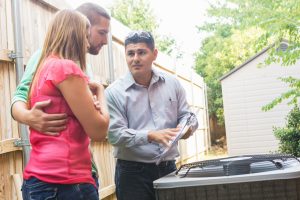Heat pump HVAC systems come in a couple of different styles and are completely different from any other HVAC units on the market today. Keep reading to learn how a heat pump can help you save energy costs, boost overall comfort, and potentially increase the temperature customization of your home.
Then when you’re ready to schedule a heat pump installation in Sacramento, CA, give us a call to schedule your in-home assessment. Heat pumps offer a versatile solution, especially in climates like ours, where both heating and cooling are needed. For additional insights, check out are heat pumps a good solution for cooling? to understand their dual functionality and energy efficiency. We can help you choose the model and design that is perfect for your family and home so you can enjoy it for many years to come.
How the Reversing Valve Enables Heating and Cooling
The reversing valve is one of the single most important components that sets a heat pump apart from a central air conditioner. With a central AC, refrigerant only moves in one direction. It absorbs heat from the inside and channels it outside.
The reversing valve is what allows refrigerant in a heat pump to move in the opposite direction. When you change the settings on your thermostat from cooling to heating, the reversing valve moves over to heating mode.
The refrigerant in the lines then moves in the opposite direction to absorb heat from outside your home and transfer it inside to increase the temperature. A heat pump can switch between heating and cooling modes as often as you need it to during the spring and fall seasons when temperatures fluctuate more.
The Role of a Second Expansion Valve in Efficiency
All central air conditioners include a single expansion valve that helps to lower the pressure of the refrigerant after it releases heat outside. When the refrigerant channels back into your house, it’s compressed enough to absorb the maximum amount of heat as it cools down the air.
A heat pump includes one additional expansion valve because the refrigerant moves in both directions and thus needs to be compressed down at different points in a heating or cooling cycle. This extra expansion valve compresses the refrigerant down during a heating cycle so the liquid refrigerant can exit your home and expand to absorb heat and bring it back in.
What Heat Pump Defrost Controls Do
We often need to use our central air conditioners and heat pumps during the winter since our temperatures are milder. This means that there is a risk of the outdoor coils freezing and developing ice buildup. Fortunately, heat pumps include defrosting controls to mitigate this issue. If you’re considering an alternative system, explore the immediate benefits of choosing a ductless air conditioning system for added flexibility in cooling. As a precaution, your heat pump includes sensors that detect ice buildup on the outdoor unit.
The defrosting controls can adjust how your heat pump is operating and boost heat outside so that the ice will melt. Then the defrosting mechanism turns off again and your heat pump resumes normal operation.
Why Backup Heat is Needed for Cold Weather
Heat pumps are highly efficient in moderate climates but may struggle to maintain adequate warmth during extreme cold spells. To address this, many heat pump systems are equipped with backup heating systems, such as electric resistance heaters or integrated furnaces. These systems activate only when outdoor temperatures drop too low for the heat pump to operate efficiently. This ensures uninterrupted comfort while minimizing energy consumption in most conditions.
How Suction Accumulators Protect the Compressor
Refrigerant moving in both directions does create some additional risks for your heat pump that a central AC doesn’t face. There’s a risk that the refrigerant could enter the air compressor and mix in with oil in the system during a heating cycle. To prevent slugging and maintain efficient operation, the suction accumulator is a critical component of your heat pump. For long-term reliability and maintenance, visit our heat pump services page or contact Sierra Pacific Home & Comfort, Inc. today. Trust The Guys in the Big Red Trucks to guide you through every step of your heat pump installation.
To offset this risk, your heat pump includes a suction accumulator that absorbs any refrigerant entering the compressor to prevent it from interfering with normal operation. If refrigerant does enter the compressor, it results in slugging that negatively impacts how well your heat pump is able to warm up your home.
Zoning Options Unique to Heat Pump Systems
Modern heat pumps can include zoning capabilities that allow for precise temperature control in different areas of your home. Using dampers and multiple thermostats, a zoned heat pump system can independently heat or cool specific rooms or zones. This customization helps reduce energy waste by ensuring only occupied areas are conditioned, leading to lower energy bills and enhanced comfort throughout the home.
Contact Sierra Pacific Home & Comfort, Inc. today to schedule your heat pump installation as soon as possible. You can always trust The Guys in the Big Red Trucks.

